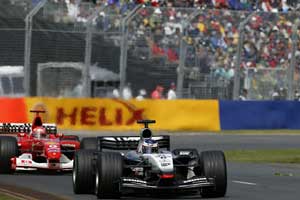MARCH 11, 2003
An interesting thought...

Formula 1 was on the verge of becoming a fuel economy formula. With diminishing returns being gleaned from a stable set of regulations and the difficulty of overtaking on the track, races were being decided more and more by the refuelling strategies. Fuel tank size was critical to how long a car could stay out on the first stint of a one-stop strategy, and one or two fast laps longer than the opposition in a light car could result in overtaking - not on the track of course, but overtaking none the less. And then Ferrari brought out its stunning 2002 challenger and, after a bit, the others noticed that it had a short wheelbase and a small fuel tank, but overall was quicker as a result. Williams, for one, designed its 2003 car along the same lines, also desirous of a shorter wheelbase for dynamic reasons. Ferrari lengthened its wheelbase... McLaren has not told anyone what it is doing with the MP4-18, which is yet to appear, but there is no doubt that if one can achieve a short car and long runs on a tank of fuel, there are racing advantages to be gained. Less fuel used in a race also means less weight to be carried on average over the race distance. In the February edition of AutoTechnology magazine, there is an interview with BMW's Dr. Mario Theissen. In it, the interviewer states that "Mercedes is working together with Bosch on introducing gasoline direct injection [GDI] on its 2003 F1 engine... Bosch is developing GDI exclusively for Mercedes, after Audi gave its permission." If the interviewer is right, (Theissen did not challenge the statement, just refused to talk about BMW's activities in this area), it begs the question why would it take on this major development? Audi has pioneered GDI in motor racing recently - Mercedes, of course, pioneered GDI in its 300SL engine in the 1950s, having learned all about it on the Daimler Benz aero-engines of World War II - but has so far only used it on its Le Mans engines. These rev only to around 7,000rpm. GDI is not a promising route to get more power in a 19,000rpm engine, even if the problems in getting the fuel to vaporise and burn in the short time available can be solved. The reason Audi uses GDI is fuel economy, which is critical in endurance racing. With GDI, it is possible to persuade lean mixtures to burn, by localising a richer mixture around the spark plug and getting a good flame to set the rest alight. Fuel economy rather than power is the likely reason Mercedes is so keen to incorporate GDI in a Formula 1 engine, and one could guess that McLaren has designed a car to exploit that - with a short wheelbase and the ability to go further on a tank of fuel. Then the regulations changed, and suddenly refuelling strategies were up in the air. Several designers said that they would have designed different cars if they had known in time. Patrick Head is claiming that the regulations have favoured the small tank Williams (i.e. race stints between refuelling will be shorter) and how much fuel you put in will no longer be determined by wishing to stay out longer than the opposition, but by more complex strategies involving potential grid positions. Lower fuel consumption is always an advantage but maybe the re-interpretation of the regulations has reduced the potential advantages of Mercedes's GDI developments, which perhaps helps to explain why Ron Dennis has been so upset about the changes...